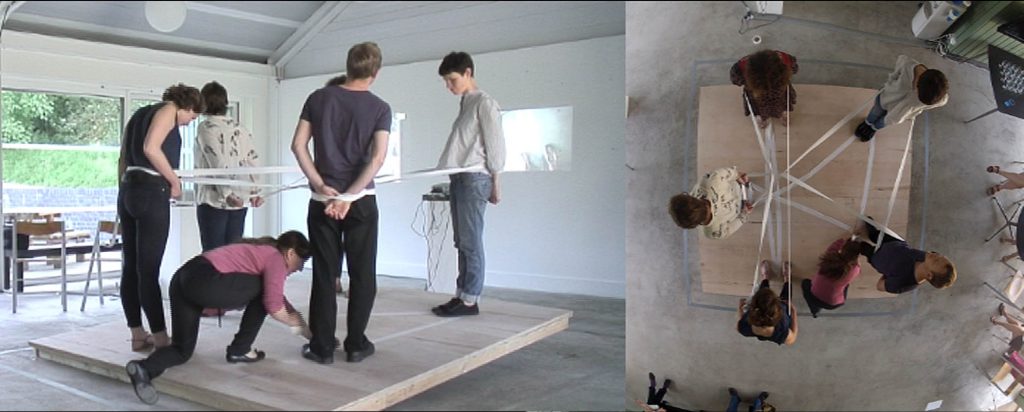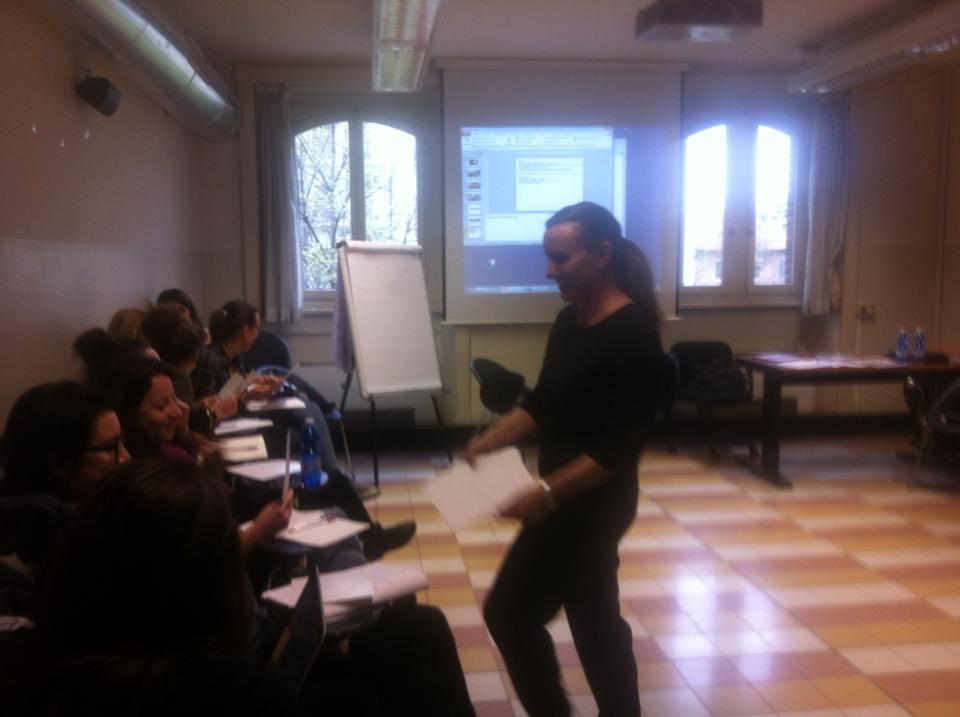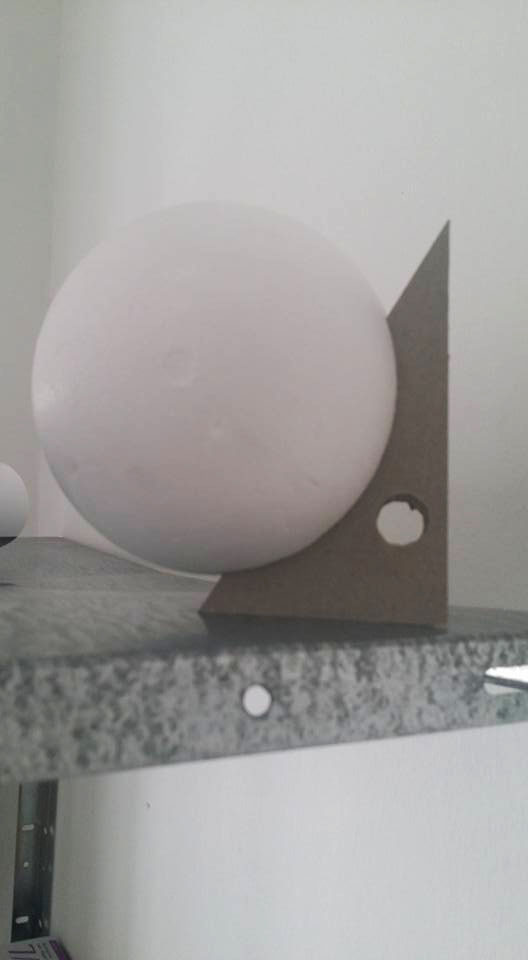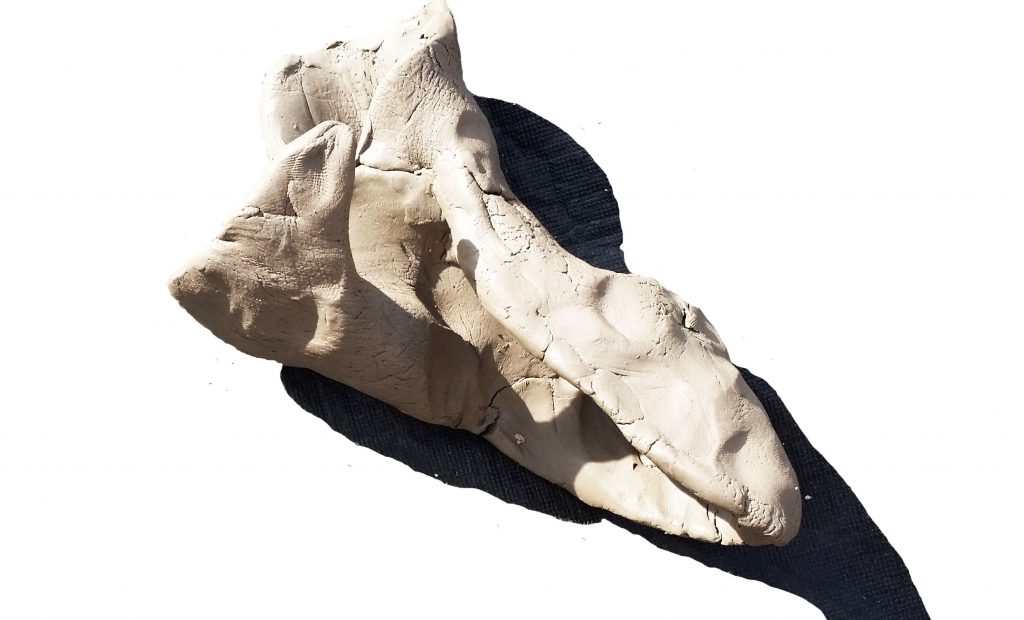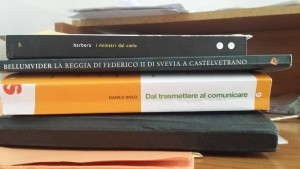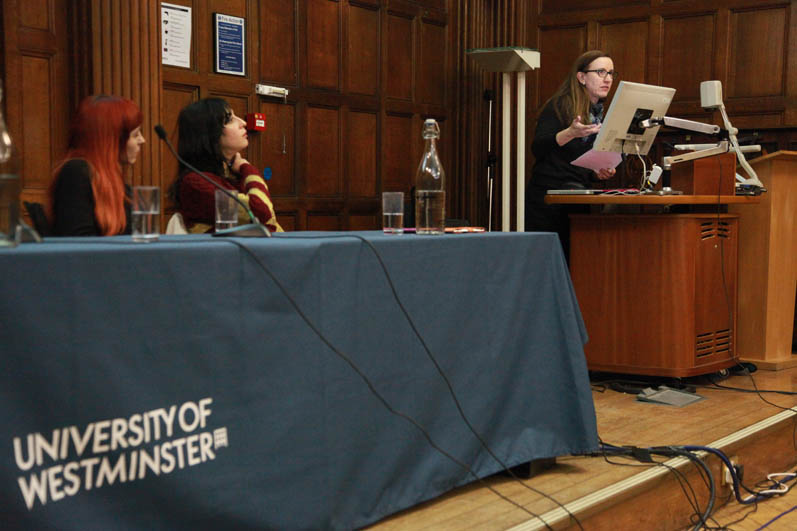Draw to Perform 3
Draw to Perform 3, London
Spa(e)cious, Elena Cologni
(live participatory performance: two live projections, wooden platform, elastic string, paper, masking tape, 2012) , video documentation of the version presented in the exhibition Wysing Arts Contemporary: Recollect, at Wysing Arts Centre, Bourn, UK
Elena Cologni was introduced by Helena Blaker, who talks about the ‘open-ended and evolutionary, unfixed and emergent quality of Cologni’s work’ (https://vimeo.com/channels/891782/49685158)
“Spa(e)cious’[i] aimed at creating the physical and psychological conditions to enhance an awareness of the illusory nature of the perception and memorization of time and space in the present. Through a strategy of spatial relations of bodies, I devised a participatory and performative activity for 5 people. This was based on the observation that the body experiences time and space while moving through, and in space, since before we learn to speak (Plumert and Spencer, 2007), in this sense we build our spatial relations with the world and others through our body first, before language develops. The piece is underpinned by elements of cognitive psychology and philosophy, in particular the Memory ‚Äď Time ‚Äď Perception relation: the definition of specious present (a present moment in which perception and memory are indistinguishable from each other, James 1890: 608); the notion of the present within duration (Bergson 1956); and, the notion of Praktognosia, experience of movement “as original and perhaps as primary‚ÄĚ (Merleau-Ponty 1962: 140). Spa(e)cious is performed through stages on a horizontally pivoted platform which interferes with our experience of the actual, and which prompts the participants to react by establishing physical and social relations in space with each other. The dynamics that took place among people on the unstable platform included: pulling each other as they are joined together with elastic string; avoiding each other as they walk on a marked path; and balancing each other, most of these happened with very few or no words exchanged. Mainly through looking, moving arms and gripping a pre-linguistic communication system was established. While restaging this work I became more interested in how the social and cognitive dynamics among the participants on the platform translated into different movements and shapes in the defined place. I then started investigating different related strategies through dialogic site specific interventions….”
extract from Elena Cologni ‘A Dialogic Approach For The Artist As an Interface in an Intercultural Society’ (2016) in Burnard, Mackinlay, Powell (Eds). The Routledge International Handbook of Intercultural Arts Research New York, London: Routledge
[i] presented at: How Performance Thinks, Conference PSi Performance and Philosophy working group and Kingston University‚Äôs practice.research.unit 2012, The London Studio Centre, London; Re-Collect, curator Ellie Morgan group show Wysing Arts Centre,¬† Bourn, UK; !KF Institut f√ľr k√ľnstlerische Forschung Berlin, Germany; Cose Cosmiche, Artra Gallery, Milan; MK Gallery, Milton Keynes, UK (2012); Lincoln University, May; PSi #19, Stanford University; Bergamo Scienza, Bergamo, Italy, with Caterina Albano; (2013); Cognitive Futures Conference, Oxford University (2015).
Biography. Elena Cologni is an artist, academic and educator, she has a PhD in Fine Art (with psychology and philosophy) from University of the Arts, London Central Saint Martins College, 2004 (CSM). Her academic positions as artist include a Post-Doctorate Fellowship at CSM (Arts and Humanities Research Council UK 2004/06), a Research Fellowship at York Saint John’s University (Arts Council of England, 2007/09). She contributes to the Commonwealth Intercultural Arts Network (University of Cambridge). She is the founder and director of Rockfluid, umbrella interdisciplinary project outcome of a residency at the University of Cambridge, Faculty of Experimental Psychology, awarded with two Grant of the Arts, Arts Council of England, and Escalator Visual Art Retreat at Wysing Arts Centre, Escalator live art, Colchester Arts Centre. This includes many international specific interventions, investigation the relationship memory, perception and place.
operare nello spazio pubblico/making work in public space
Master Progettare Cultura, Università Cattolica Milano,
su invito di
Gabi Scardi e Ivana Ghilardi
30 marzo 2016
Il contesto, da una mail a Ivana e Gabi, pochi giorni prima:
…..il concetto di valore intorno all’approccio partecipato, per inserire il mio interesse sulla memoria in una piu’ ampia visione ecologica e che si spera si possa evincere da una posizione etica insita nel lavoro.
Mi trovavo ieri a bere un te qui a Cambridge con il sociologo e antropologo Paul Connerton, il quale insisteva sui termini endurance, slowness, silence, pause, waiting: durata/resistenza, lentezza, silenzio, pausa, attesa. Partendo da una riflessione sul senso che questi hanno per me, vorrei introdurre il mio lavoro dal suo interno, e cioe’ il mio modo di rapportarmi agli altri che si basa sul vuoto (gap) lasciato per consentire un interscambio….¬† Come nel progetto ‘lo scarto’ (2015, Castelvetrano, Sicilia, e Londra UK), in cui mi sono riferita da un lato alla maieutica reciproca di Danilo Dolci, e dall’altro alla memoria proceduale (‘habit memory’) discussa da Paul Connerton (How societies remember, 1989).
Un interesse per l’esperienza della memoria che risale a quando lasciai l’Italia vent’anni fa, ma che ho affrontato in modo cosciente in rapporto ai luoghi nella serie ‘Menmonic Present, Un-folding’ (2004-05), costruendo ‘una sorta di urbanistica della memoria’ (Aurelio Andrighetto).
Il rapporto tra me (il mio lavoro) e gli altri √® un punto focale nel mio operare, ed √® da sempre alla base di un approccio interdiscipliare e trasversale in cui prendo in prestito strategie e concetti propri di psicologia e sociologia, per elaborare¬† un’ indagine attaverso una practica artistica che ruota intorno al rapporto tra memoria, percezione e spazio/luogo. Da cinque anni in particolare all’interno della piattaforma rockfluid ho affrontato questi temi attraverso progetti site specific e in collaborazione con curatori indipendenti o istituzioni.
Vorrei pero’ approfittare di questa occasione per fare una riflessione che mi permetta di definire un ambito (dai confini necessariamente instabili) per quell’aspetto del processo creativo che mi porta a rapportarmi con gli altri in determinati luoghi, che viene comunemente inteso come public art. E per fare questo vorrei riferirmi ai concetti di: spazio sociale, pratica sociale e pratica spaziale (Henry Lefebvre, Production of Space) ed al processo di attaccamento ai luoghi (Gaston Bachelard). Concetti che cerco di incorporare nel mio lavoro attraverso il dialogo, l’azione e la costruzione di memorie condivise per contribuire a quello che Assman definisce memoria comunicativa (mai tangibile e monumetale) in costante mutamento cos√¨ come la nostra societ√† attuale.
Questo momento di riflessione fa parte del processo creativo in atto per il mio prossimo progetto, che verrà definito quando sarò in residenza al MuseumQuarter a Vienna tra poche settimane.
relativi riferimenti
Cologni, E., (2016) A Dialogic Approach For The Artist As an Interface in an Intercultural Society.  in Burnard, Mackinlay, Powell (Eds). The Routledge International Handbook of Intercultural Arts Research New York, London: Routledge
Cologni, E., (2016) Lo scarto (touch) in #TransActing: A Market of Values, presented by Critical Practice, Camberwell, Chelsea and Wimbledon Graduate School’s Public Programme, July 2015
https://75gropiusartresidency.wordpress.com/2015/10/28/a-modernity-which-forgets-exhibition/
Q21 MuseumsQuartier Wien
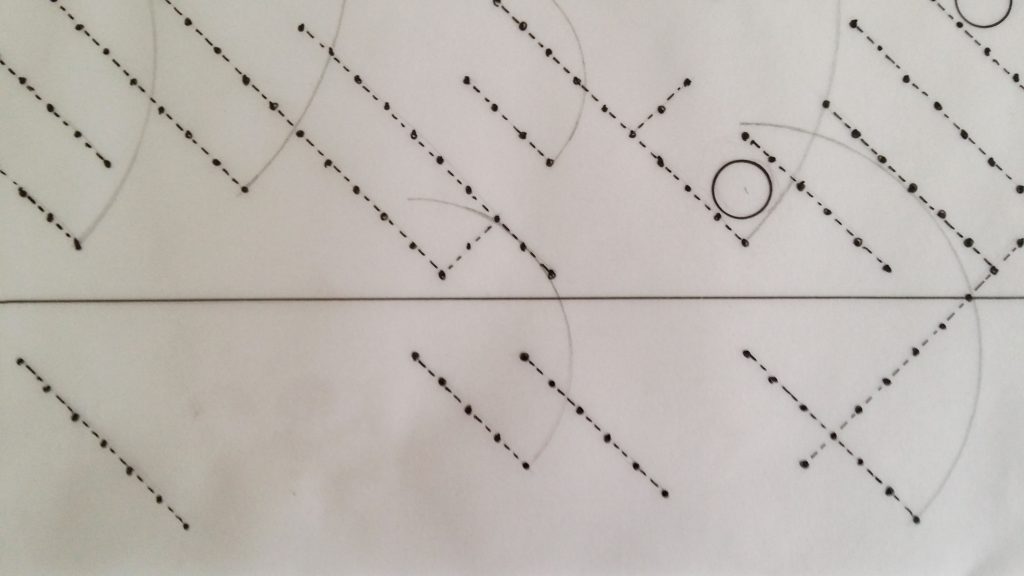 lived dialectics: movement and rest
lived dialectics: movement and rest
Elena Cologni
site specific performance
27 July 2016, 10-11:00 and 17-18:00
Venue: stroll from MQ courtyard 7 (in front of AZW) to Burgtor/ Heldenplatz
“…a pre-reflexive corporeal awareness manifested through everyday’s gestures and behaviors and typically in synch with the spatial and physical environment in which the action unfolds….bodily routines as contributing to the lived dimensions of place, including attachment grounded in habitual regularity…¬† the simple act of walking with its movement and rest patterns….”
Cologni spent a month as residency artist in Vienna to think and develop a body of work about issues of place attachment, where Freud initiated studies on mother-infant attachment. Our identity evolves in relation to our continuous engagement with place, and most importantly, in relation to others.  The context of the residency format functions as a metaphor for a temporary setting within a nomadic approach to life, a very current and widely shared social condition. Cologni invites others to physically test and feel.
Curated by Walter Seidl und G√ľlsen Bal
Image: Study for site responsive drawing (courtyard), Elena Cologni, 2016
http://www.q21.at/jp/programm//programmdetail/elena-cologni-lived-dialectics-movement-and-rest/
studio shelf, makette, Elena Cologni
My time in Vienna is an opportunity to think and develop a body of work about issues of place attachment and belonging, and within the wider context of a critical ecology of memory. My work has been addressing our continuous engagement with place, and how, in the live process of memorizing (and recollect) our experience, we change our very perception of it. Our identity inevitably evolves within this dynamics, and, most importantly, in relation to others.
Years ago, I chose to leave my country of origin, and I still now find myself in the position of renegotiating who I am in relation to it on a daily basis. As an artist recently developing almost exclusively site specific projects, in order to create the work I tend to experience a deep sense of attachment to the place, and then mourn a loss brought about by the following separation from it. This is a very current and widely shared social condition, and its effect on the individual and society as a whole is hard to predict, I can only start looking into it subjectively.
invited by frei_raum Q21 exhibition space MuseumsQuartier Wien
http://www.q21.at/artists-in-residence/artists/artistinfo/elena-cologni/
the tea break series at BIBAC
2nd International Conference on
‚ÄėBuilding Interdisciplinary Bridges Across Cultures‚Äô
(BIBAC 2016)
Monday 1st August (10.45-11.30 am)
‘The Tea Break Series: Practicing A Dialogic Approach/The Inside And The Outside’
Elena Cologni with Paul Connerton
 
to listen to oneself listening… (Dolci 1988:144)
Bodily practices of a cultural specific kind entail a combination of cognitive and habit-memory (Connerton, 1989: 88)
Elena Cologni has met with Paul Connerton a few times over a cup of tea, to discuss shared interests from the artistic and the sociological contexts, around the body, memory, and place. This session, including a practical element, will retain the  informal approach and open the discussion to participants.
Can we learn to listen? Or allow silence to speak to us? Can we visualize the space among us and inhabit it with our memories? these are among the questions raised by, and embedded in, Cologni’s participatory art project ‘lo scarto’ (2015), which evolved through the relational dynamics within the group. It was informed by the Reciprocal Maieutics Approach (RMA Dolci, 1973), a pedagogic process based on collective exploration of individuals’ experience and intuition. This enabled inter-subjective exchange, the activation of history and memories, and the construction of a narrative related to the mass migration phenomenon and the related current intercultural process taking place in South of Italy. In Cologni’s subsequent project Lo Scarto (Touch) (2015), participants connect in pairs through soft clay. This eventually becomes distorted in the process of manipulation, while defining the space between them into unique objects. Such a socially negotiated practice allows embodied memories (Connerton 1989), carried in gestures and habits, to be exchanged as a form of tacit knowledge of one another conveyed through touch.
This form of engagement, of prelinguistic dialogue, is a reciprocal dynamic of question and response. A ‚Äėquestion‚Äô already implies an openness towards the other’s background and differences (cultural, gender). In particular, in the encounter the question informs the blank space between hands, which has been inhabited. The distance between two people, a materialized topography, a ‘place memory’ (Connerton 2009),¬† acts as point of contact, exchange and separation.
Participants feel and listen in order to respond, a necessary condition for the Reciprocal Maieutic Approach (Dolci 1988, Cologni 2016) as a way of sharing one‚Äôs own experience to inform the other‚Äôs. This is also how ‚Äúcommunicative memory works, through the integration of different traditions, an aspect of which will be lost or discarded along the way‚Ķ ‚Äėlo scarto‚Äô, offcut, scrap, residue of culture‚Ķ‚ÄĚ (Cologni 2016).
Paul Connerton will respond to Cologni’s participatory practical exercise and explore some aspects of the relationship between the inside and the outside in society and with respect of the human body. He will include some of the following topos:
the aperture of the body; Lucy Harigary critique of Aristotle conception of the body as a container; the idea of internalization as developed by psychoanalysis; agrophobia; anorexia; Batkin’s idea of the grotesque body; and some features of female adornment, which, though external to the body nevertheless have radically damaging effects on the inside of the body, that is to say bone structures.
references
art projects
Cologni, E., lo scarto (touch), #TransActing: A Market of Values, presented by Critical Practice Research Cluster, Camberwell, Chelsea and Wimbledon Graduate School’s Public Programme, University of the Arts London, July 2015
Cologni, E. (2015) lo scarto, Castelvetrano, Sicily (IArt Residency Unesco, European funding)
book publications
Cologni, E. (2016) ‘A Dialogic Approach For The Artist As an Interface in an Intercultural Society’. in Burnard, Mackinlay, Powell (Eds). The Routledge International Handbook of Intercultural Arts Research New York, London: Routledge
Connerton, P. (1989). How Societies Remember. Cambridge: Cambridge University Press
Connerton, P. (2009) How Modernity Forgets. Cambridge: Cambridge University Press
Dolci, D. (1988) Dal trasmettere al comunicare, Non esiste comunicazione senza reciproco adattamento creativo, Casale Monferrato: Ed Sonda
Cologni’s research ¬†is generously funded by a Grants for the Arts, Arts Council England
Elena Cologni has a PhD in Fine Art from University of the Arts, London Central Saint Martins College, 2004 (CSM). Her academic positions as artist include a Post-Doctorate Fellowship at CSM (Arts and Humanities Research Council UK 2004/06), a Research Fellowship at York Saint John‚Äôs University (Arts Council of England, 2007/09), she contributes to the Creativities in Intercultural Arts Network (University of Cambridge). Process is central to her ‘research as art practice’ approach, which is also intrinsically interdisciplinary, and she often collaborates with academics and professionals from other disciplines. Her work include dialogic undertakings resulting in drawings, sculptures, video and text, and has been exhibited in the US, Europe and the UK. She is the founder and director of Rockfluid, umbrella interdisciplinary project outcome of a residency at the University of Cambridge, Faculty of Experimental Psychology, awarded with two Grant of the Arts, Arts Council of England, and Escalator Visual Art Retreat at Wysing Arts Centre, Escalator live art, Colchester Arts Centre. This includes many international site specific interventions, investigation the relationship memory, perception and place, including the upcoming at MuseumQuartier Vienna, Austria, and at Centre for Family Research, and New Hall Collection, Cambridge.
Paul Connerton is a research associate in the Department of Social Anthropology at the University of Cambridge. His books include How Societies Remember (Cambridge University Press, 1989), How Modernity Forgets (Cambridge University Press, 2009), and The Spirit of Mourning: History, Memory and the Body (Cambridge University Press, 2011). Connerton’s first book, How Societies Remember (1989), opened the discussion of collective memory (per Maurice Halbwachs and others) to include bodily gestures, finding in clothing, manners, musical performance, and other socially negotiated practices locii where memory is “silted” (to use his verb) into human corporeal consciousness and praxis. Connerton followed up this work with How Modernity Forgets (2009), which emphasizes what Connerton calls “place memory,” or memory that is dependent upon topography and particularly upon topography as it relates to the human body. Connerton argues that modernity is characterized by a particular sort of forgetting “associated with processes that separate social life from locality and from human dimensions: superhuman speed, megacities that are so enormous as to be unmemorable, comsumerism disconnected from the labour process, the short lifespan of urban architecture, the disappearance of walkable cities
lo scarto-scambi
ripensandoci:  il contenuto legato allo scambio, e per questo la cronologia è importante | in retrospect: the content linked to the exchange, and in this chronology is crucial
feedback da parte deo partecipanti| participants’ feedback
… comincio col ringraziarti per avermi e averci dato la possibilit√† di lavorare con te. Un lavoro del tutto nuovo che mi ha formata e fatto crescere molto, sia personalmente che culturalmente. Mi √® piaciuto lavorare all’aperto, sentire gli occhi delle persone, le voci e le mani che volevano toccare i nostri lavori. Mi √® piaciuto soprattutto il momento della “pollinazione”, ho visto la gente molto incuriosita e coinvolta e questo mi ha stupida molto, non pensavo potessero avere questa reazione positiva. Mi ha aiutata molto il gruppo, sentire davvero gli altri ragazzi che lavoravano con me, e, guardandoci, ho notato che spesso riuscivamo a capirci senza troppe parole e a ritrovare il silenzio e la concentrazione. Il lavoro fatto nei giorni precedenti mi √® servito durante le meccaniche che avevamo preparato e che poi, sul momento, ho anche cambiato diverse volte per sperimentare, insieme al mio compagno, cose nuove sulla base dei lavori fatti. Il mio, personale, miglior feedback, per√≤, l’ho avuto dal gruppo, dai ragazzi con cui ho condiviso quest’esperienza. Inizialmente ero un po’ scettica, la mia prima parola usata quando dovevamo descriverci √® stata “fredda”. Ero fredda non a causa del vento. Conoscevo soltanto una ragazza e tutti gli altri mi sembravano molto lontani dal mio mondo. Poi, parlando e lavorando, quella persona “fredda” √® andata via per lasciare spazio ad una pi√Ļ aperta e ricettiva. Un nuovo modo di lavorare e un nuovo modo di imparare, prendere dal donare… (Roberta Marchese)
… I shall start by saying thank you to allow me/us to work with you. A completely new approach which has made me grow both personally and culturally. I liked to work outdoors, feel people’s eyes, voices, and their hands which wanted to touch the works we were holding. I particularly likes the “pollination” moment, I saw people very curious and engaged, and this was very surprising for me, I did not think they could have such a positive reaction. The group helped me a lot, really feeling others working with me, and, by looking at each other, I noticed that we could often understand each other without too many words, and to find silence again, and focus.¬† Our training in the days before was useful during the mechanics we had prepared and then, on the spot, I have also changed them many times to experiment, together with my partner, new things based on things we had done before. My personal, and best feedback, though, was what I had from the part of the group, from the guys with whom I shared this experience. I had approached this with a but of skepticism, my first word used when we had to describe ourselves¬† was “cold”.¬† I was cold not from the wind. I only knew one girl and all the others it seamed very far from my own world. Then, through talking and working, that “cold” person left to leave room for a more open and receptive one. A new way of working and a new way of learning, taking from giving.¬†
Hybridity of space
The activities are informed by a phenomenological approach¬†¬†adopted in the dialogic¬† and interactive activities in physical space, in relation to the ‚Äėspace of flows‚Äô (from the condition of embedding technology in our daily life). In particular the actvities will¬†¬†emphasise arising issues of simulataneity and presentness within the encounters and creative undertakings¬†. All of this will thus happen in a¬† new hybrid space .
Castells, M. (2011) The Rise of the Network Society, Wiley & Blackwell
on balancing
from a facebook discussion:
-
Elena Cologni Thanks¬† Pam for prompting me. My¬† artistic practice develops with my awareness of my role of artist functioning as interface within intercultural dynamics in cities (through the adoption of an overlapping psychological perspective as well www.rockfluid.com), and to investigate intercultural exchange through art. In recent site specific participatory projects Navigation Diagrams¬† (MK Gallery, Milton Keynes UK 2013), L’elastico (Ruskin Gallery, Cambridge, UK, 2012) and this, Balancing (Doppelgaenger Gallery, Bari¬† Italy 2014) I adopted a dialogic based process by which I act as an agent within a social context over a period of time to inform her creative undertakings which result¬† in a stratification of meanings from different cultures including my own (cultural memory) as transnational artist. Memory is at the centre of my practice, and of my interest in the construction of subjectivities. Furthermore, in the current digital driven context this is believed to be unstable and eveshifting. In particular is part of the project radio materiality curated by vessel and addresses issues of identity within the mediterranean region. Overall my artistic research practice is grounded in phenomenology and emphases for example interchange within shared lived space. This can be referred to as the performativity aspect in the work, which is also activated when I am no longer present, but my work (which is participatory) is. The spintops, while carrying selected words form the dialogues with mothers based in the city of Bari, are heavy and allow people to have a very specific physical experience while playing
Bari
Westminster University
Exhibiting Performance
My first old fashion style paper delivery after, yes, 12 years….I figured I need to contextualise now.
It was on the document and the quality of the unfinished as political position in my practice, but actually¬†an incredible¬†number of people discovered Philip Auslander now (!), I got hold of that article back in 2006! (well¬† he sent it to me, thanks Philip…)
phenomenology- lived space – interchange – trust
vision and technology 2, on 23 June
… and infact going around the Institute of Astronomy I could link everything quite well for video projection, text installation, and site specific intervention
it will happen on 23rd June
categories
As I was posting the information about SPA(E)CIOUS, I found it very difficult to place it in any of the categories I had initially created for rockfluid and for this website.
SPA(E)CIOUS is a term I created to mean a specific condition I want to share with others, involving time and space. It is a live piece, but it is not a performance, it is not reharsead and it changes slightly everytime because I know I would want to point the attention to slightly different elements in it everytime it is offered.
It’s possibly¬†an activity of thinking in the making, and in which other people take part. Workshop is a term I now find too generic for this.
So any thoughts? Roberto help out!
vision and technology
Then Bronac came to the studio¬† a couple of weeks ago and saw all my background in my current work: the anti-ocularcentric context I place my work in, understood my engagement in Phenomenology, and read the video in those terms, and beyond my references strictly within this project. This is the link where technology and my interest in the views from above are just like perspective back then (I mean my PhD time). Well maybe another project…
War and Cinema: The Logics of perception, Paul Virilio
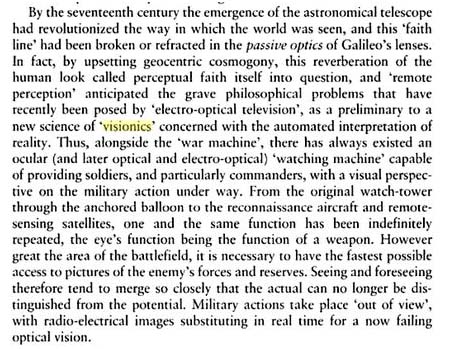
interference and the present
it was the word around which Caterina, Lisa¬†and I discussed processes of memorisation. Since then this has also been in my mind and in the studio the video, the drawings, and a 3D structure have embedded a sort of interference. Mainly to do with our physical experience in space. It is when we find an obstacle that we have to stop thinking other things and have concentrate in that¬†moment¬†on how to face it. The present moment. I guess is the condition many of us find themselves in: that of being away…., there is no time for nostalgia, memories make sense in the moment we recollect them wherever we are. They become something else with us changing. We loose a sense of identity linked to a terrotory with boundaries, its food, culture and history. We gain a sense of independence by learning to like the taste of the present.
video tiles and interference
after a discussion with Lisa Saksida on the concept of interference.
within the video editing, simple shapes in tiles which are mirrored and reversed, every so often a very short video carrying the
narrative interferes with the modular pattern, it goes very quick, the eye of the viewer looks for it
POTATO-PRINTING, A GAME FOR WINTER EVENINGS (Bruno Ernst on Escher)
the role of verbalisation in the thinking process
This is in the context of thinking about interdisciplinary practice and participatory work which in my case implies participatory methods of research.
The workshop format and similar contexts, represent for me a punctuation mark in the development of the crative process. I rely in these forums for discussion and making, here is where the exchange takes place and enriches both myself and the participants.
Have opportunities for verbalising thoughts is a process that is not that different from that implied in drawing. But in verbalisation one has a counterpart one has to make sense to. Others are wittnesses and participants in this process. We co-function in this process. discuss….
going back to ‘vision’
memory-document, mainly video, technology, opposites, macro-micro, from inside, from outside, east-west,
shouldn’t I go back to Martin Jay and add something like aspects of the middle east and technology, now starting to make sense and giving more depth to what I do here.
Methodology, Education, Art
13 February, Mphil Arts Culture and Education, Faculty of Education at Cambridge University
My active¬†lecture¬†‘Visual Art: Practice and Research defined by each other’ tried to¬†propose participatory art within¬† action reasearch framework, and ¬†participatopry research models.
Within this art practice as research is an element, the visual allowing for more deep, open, subjective, critical communication with participants. Participants are involved¬†at different stages of the developemnt of the project and their input moves the path of the project itself. Participants have different roles: co-researchers, technicians, public and intervene at different stages of the project…
Interesting discussion emerged, below students introduction

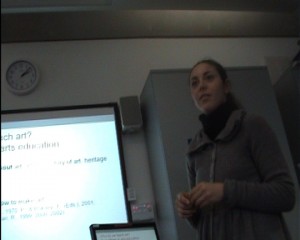
active particiaption and drawing exercise below
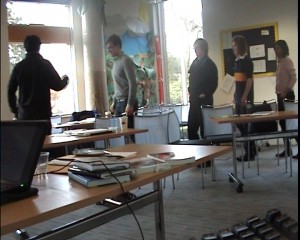
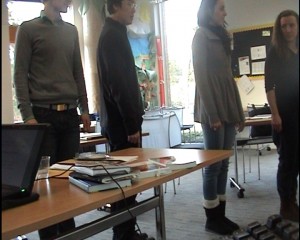

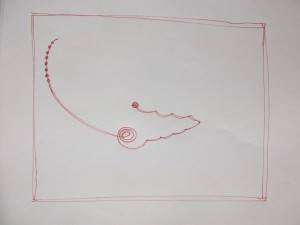
and Cologni, back to discussion  afterwards

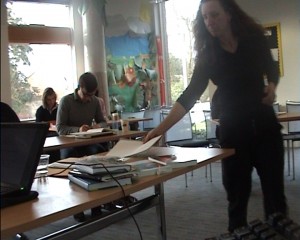
studio work, 8 Feb
then I started drawing diagrams for hopscotch on the floor. I need different kinds though. It made sense to take the drawings on paper back onto the floor… it is really so fulfilling to realise that no matter how you think hard at making art, the making is really what it is all about and the thinking, well….
It is about moving your body in the space you occupy, within which the epiphany takes place
http://www.youtube.com/watch?v=xMfhhbQnVZA&feature=related
studio work, 3 Feb
SMALL AND BIG
in my studio… the drawings form the cambridge tours are hanging on the wall…
http://www.youtube.com/watch?v=0HNAmEHFULU&feature=related
